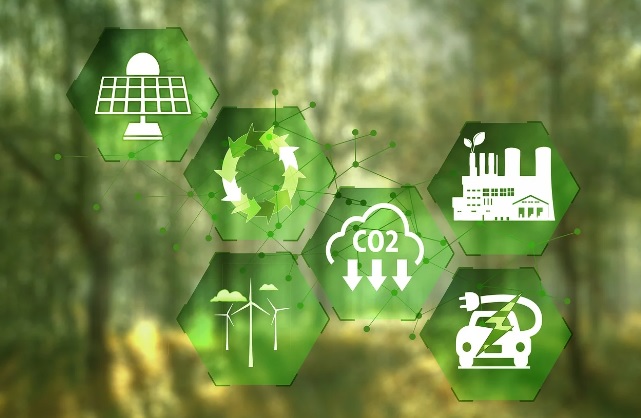We are living in an era of technological marvels; where in new industrial revolution is triggered by new advances in science and technology. The beginning of long-distance communication happened in 1800 with first electromagnetic telegraph. The technology has come a long way from there giving the human race new inventions like telephones, computers, mobile phones, internet, and finally heading towards Internet of Things (IoT) and generative AI. The internet has revolutionised the world and successive technological changes have let humans exercise a greater influence over natural resources. This combined with the ever-growing population has resulted in heavier use of raw materials, increased production, substantial resource depletion and rise in carbon di-oxide emissions. While developing new products, we tend to forget the amount of energy they produce as well as they consume. This is harming the environment gradually.
At the same time, technology has been a boon to the humankind, empowering individuals to connect with other individuals, systems to connect with other systems situated at a distance unknown via digital means. We cannot imagine a world without mobiles and internet. Thus, the need of the hour is to build solutions where technology (represented by blue colour) plays a key role to “go green”. The essence of humanity, awareness and green technology is prime to sustainability. There is a critical requirement of development of practices and procedures that prioritises resource conservation and environmental governance while stepping up efforts to decarbonize the atmosphere.
Internet, being the most radical innovation of the digital age, has transformed communication, connectivity, knowledge accessibility and social interactions. Though single internet search or email the energy need for energy is small, the cumulative CO2 and greenhouse gas emission rises up drastically on global internet usage. The carbon footprint of electronic gadgets, the internet, and the systems supporting them account for approximately 3.7% of global greenhouse emissions. IoT has contributed largely in reducing energy waste by converting normal devices into smart devices, which promotes environmental sustainability by optimised use of conventional power sources, making reuse of materials, and recycling products; thereby further reducing waste and carbon emission. It is improving the quality of life while raising environmental sustainability initiatives. IoT can be combined with technologies like AI, machine learning, computer vision, cloud computing, nanotechnology and big data to develop environmentally sustainable solutions for a better and fulfilled life.
The hardware and software being used for enjoying the fruits of technology also plays a crucial role in environment conservation. The general conception is towards making IT hardware energy efficient and environmentally friendly to reduce carbon emission, but less people know that software also results in carbon emission. Algorithms and web sites being developed are more dynamic and effect hardware’s energy consumption. Green IT involves manufacturing energy efficient recyclable computing devices, communication protocols, and networking architectures. Nano Data Centres are more energy-efficient than conventional data centres.
Greenness in software is emerging as a quality attribute. The green software design involves building software with low environmental impact, reusable functionality, along with minimal computational and memory resource requirements. Green software development spans the entire software development life cycle and needs to be followed at every phase to implement greenness in the software. Low-code development, green coding together with Automated Software Quality Monitoring are emerging as the obvious step for technology providers to minimise the energy consumption of software. The choice of language, AI models and software development techniques also contribute to developing greener software. The developers should focus on removing unused features and inefficient loops in the code as well as limit apps’ computational accuracy as required for operational needs and to monitor its real time energy consumption.
Many organisations like Microsoft, Accenture, GitHub and ThoughtWorks to name a few have joined hands to address the global climate crisis and make sustainability a top priority amongst software teams, alongside performance, security, cost and accessibility. They have collaboratively established the non-profit Green Software Foundation to promote green software development. Their main focus is on developing sustainable software which reduces carbon emission; tools and resources for developers to measure and manage energy consumption.
The common man can also contribute towards greenness by following some simple principles:
- Save power to save the planet. Turn off the facilities that are not needed. People tend to use online videos to fall asleep, which place unnecessary demand on data centres and harms the climate.
- Send only the data that is needed, as data transmission, especially streaming videos, consumes quite a lot of energy. A one-minute cell call has a slightly larger carbon footprint than sending a text, but internet video calls have a substantially higher carbon impact.
- Delete unwanted mails, as old mails also emit some small amount of carbon. Please stop sending unnecessary “Thank you” mails. This would save a huge amount of energy cumulatively.
- Reduce the resolution of screen images on a mobile app with a heavy user base to save a lot upon energy.
Make people around you aware about these green practices. It’s important to raise awareness to initiate action at the individual level and spread through the people and organizations. Let’s revel in the technology judiciously and build a sustainable and greener planet, for us and our coming generations to live a healthy and smart life.
Written by Dr. Anubha Jain, Director, School of Computer Science & IT, The IIS University (Jaipur – India).






Recent Comments